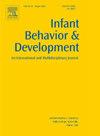Longitudinal changes in consonant production in infant-directed speech and infants’ early speech production from 6 to 12 months
IF 1.9
3区 心理学
Q3 PSYCHOLOGY, DEVELOPMENTAL
引用次数: 0
Abstract
Previous research suggests that acoustic features of infant-directed speech (IDS) might be beneficial for infants’ language development. However, consonants have gained less attention than vowels and prosody. In the current study, we examined voice onset time (VOT) – a distinguishing cue for stop consonant contrasts – in IDS and adult-directed speech (ADS), and its relation to infants’ speech production. We used a longitudinal sample of 48 Norwegian parent-infant dyads. Parents’ IDS and ADS were recorded in-lab at three timepoints (infants’ age: 6, 9, 12 months), and the VOTs of the stop consonants /b-p/, /d-t/, and /g-k/ were measured. In addition, at each timepoint, parents reported their infants’ production of the same consonants, as well as their babbling. Hypotheses were preregistered, and we used full-null model comparisons to minimise type I-errors in the analyses. Our results demonstrate that, while controlling for speaking rate, in IDS, parents’ VOTs were longer in voiceless stops, but shorter in voiced stops, resulting in overall less distinct consonant contrasts compared to ADS. Further, VOTs in IDS approached ADS values with infants’ age. However, we found no relationship between parents’ VOTs and infants’ consonant production or babbling. Consonants, like vowels, appear to be less distinct in IDS than ADS, thus reinforcing the interpretation that IDS may serve an attentional and/or affective aim, rather than a didactic purpose.
6 - 12个月婴儿导向语和早期语言产生辅音的纵向变化。
先前的研究表明,婴儿定向语的声学特征可能对婴儿的语言发展有益。然而,与韵律和元音特征相比,辅音得到的关注较少。在当前的研究中,我们研究了语音开始时间(VOT) -一个区分停止辅音对比的线索-在IDS和成人指向语(ADS)中,以及它与婴儿语言产生的关系。我们使用了48对挪威父母-婴儿的纵向样本。在实验室中记录3个时间点(婴儿6、9、12个月)父母的IDS和ADS,并测量停止辅音/b-p/、/d-t/和/g-k/的vot。此外,在每个时间点,父母报告了他们的婴儿发出相同辅音的情况,以及他们的咿呀学语。假设是预先登记的,我们使用全零模型比较来最小化分析中的i型误差。我们的研究结果表明,在控制说话速度的情况下,在IDS中,父母的VOTs在不发音停顿时更长,但在浊音停顿时更短,导致与ADS相比,整体上辅音对比不那么明显。此外,随着婴儿年龄的增长,IDS的VOTs接近ADS值。然而,我们发现父母的VOTs与婴儿的辅音产生或咿呀学语没有关系。辅音,像元音一样,在IDS中似乎没有ADS那么明显,因此强化了IDS可能服务于注意力和/或情感目的的解释,而不是教学目的。
本文章由计算机程序翻译,如有差异,请以英文原文为准。
求助全文
约1分钟内获得全文
求助全文
来源期刊

Infant Behavior & Development
PSYCHOLOGY, DEVELOPMENTAL-
CiteScore
4.10
自引率
4.80%
发文量
94
期刊介绍:
Infant Behavior & Development publishes empirical (fundamental and clinical), theoretical, methodological and review papers. Brief reports dealing with behavioral development during infancy (up to 3 years) will also be considered. Papers of an inter- and multidisciplinary nature, for example neuroscience, non-linear dynamics and modelling approaches, are particularly encouraged. Areas covered by the journal include cognitive development, emotional development, perception, perception-action coupling, motor development and socialisation.
 求助内容:
求助内容: 应助结果提醒方式:
应助结果提醒方式:


